Swine Nutrition
Feed is a huge factor in successful pig production, representing 60-75% of the cost of raising a pig to market weight. Choosing the appropriate feed for the stage of growth has a direct effect on how long it takes to get a pig to market weight, how much it costs, and the effect on meat quality.
Pigs are monogastric animals which means that they are simple stomached with a digestive system that is very similar to humans. As with humans, pigs are omnivores (eat food of both plant and animal origin). This differs from cattle and sheep that are ruminants (having a rumen) and herbivores (eat food from only plant sources).
Pigs require balanced nutrition that provides:
Energy (fats and carbohydrates): in swine feeds that include barley and wheat.
Protein that can be sourced from soybean or canola meal which is a high quality, high percent protein ingredient commonly used in swine diets.
Fiber is a common constituent of pig feeds. The addition of some types of high-fiber ingredients in the diet may have beneficial effects on satiety, growth performance and overall health of pigs. Fiber also promotes intestinal motility and prevent constipation. This is extremely beneficial in farrowing sows as constipated feces in the colon may physically block the birth canal and lead to still born piglets.
Vitamins and minerals: Although present in the diet in relatively small amounts, vitamins and minerals are essential for the proper functioning of all physiological processes. Deficiencies, excesses and imbalances in vitamins and minerals can cause health and/or production issues.
Fiber is a common constituent of pig feeds. The addition of some types of high-fiber ingredients in the diet may have beneficial effects on satiety, growth performance and overall health of pigs. Fiber also promotes intestinal motility and prevent constipation. This is extremely beneficial in farrowing sows as constipated feces in the colon may physically block the birth canal and lead to still born piglets. Note that high fiber ingredients in the diets of growing piglets and lactating sows can be detrimental as the nutrition needs are high during these stages of the production cycle.
Water: Access to clean water is an essential part of a pig’s diet. Although not a feed nutrient per sé, water is one of the most important components of a feeding program for swine. Vital to all body functions, water accounts for as much as 80% of body weight in pigs at birth, declining to about 50% at market.
Growing pigs can drink upwards of 10 litres of water per day during hot weather. Clean water should be available and easily accessible at all times, whether provided by a drinker nipple or in tubs or troughs.
The quality of this water should be considered as well. Water testing is available from numerous laboratories in Saskatchewan. click here for a list.
The following Swine Nutrition Guide, 2nd Edition was developed in the 1990’s by Dr. J.F. Patience, Dr. P. Thacker and Dr. C. DeLang at the Prairie Swine Centre and University of Saskatchewan and is still the industry standard for swine nutrition. The guide is still considered to be a valuable resource for swine nutrition today!
Swine Nutrition Guide
2nd edition


